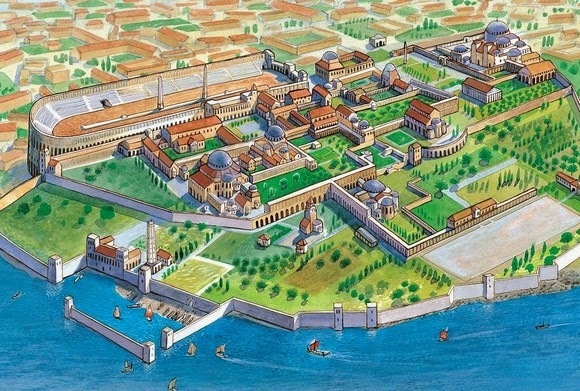Introduction
In present day Istanbul or Constantinople, as the city has been named for most of its history, one can see the historical remnants of lavish periods of its past, ruled by leaders who often exerted power on the city and region through the construction of extravagant buildings. Some of these buildings, like the Sultanahmed Mosque, are still existent to this day. However, the Great Palace of Constantinople is not one such example. Instead, the Great Palace, as seen through the figure to the left, was once the lavish “ceremonial heart of the Byzantine Empire” (1). However, the once-extravagant structure is currently buried under the Sultanhamed Park, the Sultanahmed Mosque and the Great Palace Mosaics Museum, which exhibits mosaics of the palace that have been excavated in the past century. While the contemporary palace is currently in complete disuse, its history reveals interesting transitions in attitude by the people and rulers of Constantinople from heavy utilization in the Early Byzantine period to complete ruin and abandonment in the Ottoman Empire. In today's society, the attitude toward the palace has taken a complete turn, where archaeologists and historians have tried and are attempting to excavate and revitalize the memories of the Great Palace, a building that once represented the extravagant rule of leaders like Constantine the Great.
This attempt to revitalize memories of the Great Palace presents the palace as an intriguing “lieux de mémoire” of Istanbul’s history. Pierre Nora in his essay “Lieux de Mémoire” defines the term as such, “A lieux de mémoire is any significant entity, whether material or non-material in nature, which by dint of human will or the work of time has become a symbolic element of the memorial heritage of any community.” (2) The physical site of the Great Palace, which is in practice “nonexistent” and “absent” through being occupied by other structures, presents a fascinating interplay between presence and absence and especially highlights the absence of the original structure. Altogether, this current site and its emphasis on absence ironically acts as a lieux de mémoire that marks the fleeting presence and celebration of the palace. The lieux de memoire also highlights the progression throughout history of attitude toward the palace, represented by a transition from celebration to abandonment and subsequent ruin and then a rapid and contemporary shift toward a desire to resurrect a building that was discarded and abandoned for centuries.
Works Cited
1. Westbrook, Nigel. "An Architectural Interpretation of the Early Byzantine Great Palace in Constantinople, from Constantine I to Heraclius." The University of Western Australia, Feb. 2013.
2. Nora, Pierre. "Between Memory and History: Les Lieux De Mémoire." Representations 26 (1989): 7-24.

